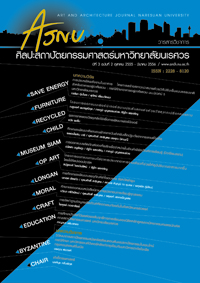การประหยัดพลังงานในอาคาร โดยการสร้างสภาวะน่าสบายด้วยวิธีปรับเย็นแบบธรรมชาติ
Main Article Content
Abstract
การประหยัดพลังงานในอาคารโดยการสร้างสภาวะน่าสบายด้วยวิธีปรับเย็นแบบธรรมชาติสำหรับอาคารอยู่อาศัยรวม เป็นงานวิจัยเชิงประยุกต์มีวัตถุประสงค์เพื่อศึกษาลักษณะและรูปแบบทางสถาปัตยกรรมตลอดจนศึกษาแนวทาง ผลกระทบ ข้อดี ข้อเสียของวิธีการสร้างสภาวะน่าสบายด้วยวิธีปรับเย็นแบบธรรมชาติ และการนำมาใช้รวมทั้งศึกษาแนวทางในการปรับปรุงและพัฒนาระบบการสร้างสภาวะน่าสบายด้วยวิธีปรับเย็นแบบธรรมชาติที่เหมาะสมกับอาคารอยู่อาศัยรวม โดยมีอาคารอยู่อาศัยรวม มน.นิเวศน์ 5 มหาวิทยาลัยนเรศวร เป็นอาคารกรณีศึกษาผลการวิจัยพบว่าอาคารอยู่อาศัยรวม มน.นิเวศน์ 5 ซึ่งเป็นอาคารคอนกรีตเสริมเหล็กสูง 9 ชั้น มีลักษณะของอาคารเป็นรูปทรงแบบเปิด (Open Form) ห้องพักต่างๆภายในอาคารสามารถสัมผัสกับธรรมชาติได้อย่างเต็มที่ อีกทั้งยังมีรูปแบบของอาคารพักอาศัยที่เป็นแบบทางสัญจรเดี่ยว(Single Load Corridor) ซึ่งมีทางเดินจ่ายไปตามห้องพักต่างๆปัญหาความร้อนจากแสงแดดที่ส่องกระทบกับผนังอาคารอย่างเต็มที่จนทำให้อุณหภูมิอากาศภายในห้องพักสูงเกินไปรวมทั้งอุณหภูมิที่ผิวผนังและอุณหภูมิที่ผิวฝ้าเพดานภายในห้องพักมีค่าสูงด้วยแนวทางการปรับปรุงคือการปรับกรอบอาคารให้มีค่าการต้านทานความร้อนที่ดีขึ้นโดยการติดตั้งฉนวนใยแก้วที่ผนังและฝ้าเพดาน ตลอดจนการติดตั้งแผงกันแดดบริเวณระเบียงห้องเมื่อได้ทำการประเมินผลการปรับปรุงโดยใช้โปรแกรมคอมพิวเตอร์ (Ottvee) คำนวณค่าการส่งผ่านความร้อนรวมผ่านผนังอาคาร (OTTV) และค่าการส่งผ่านความร้อนรวมผ่านหลังคาอาคาร (RTTV)เป็นเกณฑ์ในการประเมินพบว่าหลังการปรับปรุงค่า OTTV ลดลงไปได้ 27.5 % สำหรับห้องพักที่อยู่บริเวณกลางอาคาร และค่า OTTV ลดลงไปได้ 42 % สำหรับห้องพักที่อยู่ด้านริมอาคาร และค่า RTTV ลดลงไปได้ถึง 75 % สำหรับห้องพักที่อยู่บริเวณชั้นบนสุดของอาคาร
ปัญหาที่เกิดจากระบบการระบายอากาศของห้องพักที่ยังไม่เหมาะสมกระแสลมธรรมชาติจึงพัดผ่านเข้ามาได้อย่างจำกัดทำให้ในห้องพักมีความชื้นที่อยู่ในระดับสูงแนวทางการปรับปรุงอาคารคือการเพิ่มจำนวนช่องเปิดเหนือและใต้หน้าต่างบานเลื่อนเดิมของห้องนอนเล็กให้มากขึ้นเพิ่มขนาดและจำนวนของหน้าต่างบานเกล็ดกระจกฝ้าภายในห้องน้ำเพื่อให้สามารถรับลมและแสงธรรมชาติได้มากยิ่งขึ้นรวมทั้งการเปลี่ยนชนิดของบานเปิดในห้องนอนใหญ่และในห้องครัวจากเดิมที่เป็นหน้าต่างบานเลื่อนเป็นหน้าต่างบานเปิดเพื่อให้กระแสลมสามารถพัดผ่านเข้ามาได้มากขึ้นเมื่อได้ทำการประเมินผลแนวทางการปรับปรุงโดยการเปรียบเทียบค่าความเร็วลมในอาคารจริงกับค่าความเร็วลมในอุโมงค์ลม (Wind tunnel) พบว่าในการวัดค่าความเร็วลมในอาคารจริงนั้นค่าความเร็วลมโดยเฉลี่ยสำหรับห้องที่มีกระแสลมพัดผ่านเข้ามาได้น้อยที่สุดมีค่าร้อยละของความเร็วลมจากภายนอกที่สามารถพัดเข้าสู่ภายในตัวอาคารได้คิดเป็นค่าที่ต่ำสุดคือ 1.08% และมีค่าที่สูงที่สุดคือ 2.00% แต่หลังจากการแก้ไขปรับปรุงแล้วนำไปทดสอบค่าความเร็วลมภายในอุโมงค์ลมโดยใช้การจำลองสภาพด้วยหุ่นจำลองพบว่าสำหรับห้องที่มีกระแสลมพัดผ่านเข้ามาได้น้อยที่สุดนั้นมีค่าร้อยละของความเร็วลมจากภายนอกซึ่งสามารถพัดเข้าสู่ภายในตัวอาคารเพิ่มมากขึ้น โดยมีค่าที่ต่ำสุดคือ 2.94% และค่าที่สูงสุด 49.06%
ปัญหาที่เกิดจากค่าความส่องสว่างจากแสงธรรมชาติในอาคารยังไม่มีประสิทธิภาพเพียงพอแนวทางการ ปรับปรุงมีอยู่สองแนวทาง คือ พื้นที่ที่มีค่าความส่องสว่างมากเกินไป สามารถแก้ไขได้โดยการติดตั้งแผงกันแดดเพิ่มที่ บริเวณระเบียงห้องพักเพื่อลดปริมาณแสงสว่างลง แนวทางที่สองสำหรับพื้นที่ที่มีค่าส่องสว่างน้อยเกินไปสามารถแก้ไขได้ โดยการการเพิ่มจำนวนช่องเปิดเหนือและใต้หน้าต่างบานเลื่อนเดิมของห้องนอนเล็กให้มากขึ้น รวมทั้งการเพิ่มขนาดและจำนวนของหน้าต่างบานเกล็ดกระจกฝ้าภายในห้องน้ำให้มากขึ้นเพื่อให้แสงธรรมชาติส่องผ่านข้ามาในอาคารได้มากขึ้นเมื่อได้ทำการประเมินผลแนวทางการปรับปรุงโดยใช้โปรแกรมคอมพิวเตอร์ (Dialux) คำนวณค่าการส่องสว่างของแสง ธรรมชาติเป็นเกณฑ์ในการประเมิน พบว่าที่บริเวณห้องนั่งเล่นที่อยู่ติดกับระเบียงก่อนการปรับปรุงมีค่าความส่องสว่างเฉลี่ยอยู่ที่ 559.18 lux เมื่อได้ทำการปรับปรุงอาคารโดยการติดตั้งแผงกันแดดที่ระเบียงแล้วพบว่าค่าความส่องสว่างเฉลี่ยมีค่าลดลงเล็กน้อยอยู่ที่ 548.35 lux ที่ห้องนอนเล็กก่อนการปรับปรุงมีค่าความส่องสว่างเฉลี่ยอยู่ที่ 226.47 lux เมื่อได้ทำการปรับปรุงอาคารโดยการเพิ่มจำนวนช่องเปิดของห้องนอนเล็กให้มากขึ้นพบว่าค่าความส่องสว่างเฉลี่ยมีค่า เพิ่มขึ้นอยู่ที่ 358.84 lux และที่ห้องน้ำ ก่อนการปรับปรุงมีค่าความส่องสว่างเฉลี่ยอยู่ที่ 285.13 lux เมื่อได้ทำการปรับปรุงอาคารโดยการเพิ่มขนาดและจำนวนของหน้าต่างบานเกล็ดในห้องน้ำให้มากขึ้นพบว่าค่าความส่องสว่างเฉลี่ยมีค่าเพิ่มขึ้นอย่างมากอยู่ที่ 676.8 lux
Energy Conservation by Passive Cooling Methods of Creating Thermal Comfort for Apartment Building: A Case Study of Mo-No Nivet No.5 Staff Residence, Naresuan University
As an applied research, energy conservation by passive cooling methods for creating thermal comfort in apartments has the main objective to determine the passive cooling methods that are suitable for building characteristics of apartments. To do this, previous studies about multi-storey residential buildings were reviewed to analyze several passive cooling methods in terms of their applications and limitations. The researchers then developed the passive cooling method suitable for apartments in Phitsanulok by using a residential building, Mono Nivet no.5 as the case study. This reinforced concrete building has nine storeys. Its open form (U-shaped plan) allows all residential units to connect to outdoor environment. With single load corridor which all units are on one side, the corridor itself opens to the surroundings. Four major energy-related problems due to poor building design can be concluded as follows:
1. Excess heat load on the wall structure. As the apartment’s walls are exposed to sunlight for a long time during a day, a large amount of heat transferred to exterior wall and ceiling, leading to high temperature in each residential unit. All the building envelope components should therefore be higher heat resistant. To increase R-value, insulating walls and ceiling and installing external shading devices can effectively reduce heat transfer rate. Calculated overall thermal transfer value (OTTV) and roof thermal transfer value (RTTV) by using Ottvee software, it is found that the OTTV decreases by 27.5% for the units in the middle of U-plan and 42% for the units in two wings of the building with building retrofit. The RTTV also decreases by 42% for the units on the top floor.
2. Inadequate ventilation. Due to the small amount of fresh air flowing through, the unit contains high moisture. To solve this problem, increasing the number of opening above and below the existing sliding windows of small bedrooms and enlarging frosted louvered window of toilet help to allow more air and daylight entering the rooms. Replacing the sliding windows of master bedrooms and kitchens with double-hung windows also increase air movement inside the unit. The improvement of air flow rate was tested by comparing wind velocity measured in the building with that measured in wind tunnel. The percentage of wind velocity from the exterior to the interior measured in the building ranges from 1.08% to 2.00% for the room with the lowest air flow. With changes in window sizes and number, the percentage of wind velocity from the exterior to the interior measured in the wind tunnel increases, the lowest value is 2.94% and the highest value is 49.06%.
3. Problems with natural light. Two improvements can be made to reduce heat gain caused by poor daylighting design. To protect the front door of each unit from the exposure to excessive light, the first improvement is to install shading devices at the corridor. On the other hand, inadequate natural lighting was found at the small bedrooms and toilets due to the small areas of glazing, leading to increased use of artificial light and high heat gain from the light bulbs. The improvement of ventilation can immediately increase daylight as more glazing in small bedrooms and toilets allow more visible light to penetrate further into the rooms. Assessed the results of two improvements by using Dialux software, the researchers found that the illumination of the living area adjacent to the corridor decreased from 559.18 lux to 548.35 lux and the illumination of a small bedroom increased to 358.84 lux. More glazing in toilet can significantly increase the illumination from 285.13 lux to 676.8 lux.
4. High humidity due to rain splashing on the corridor and hallway in front of the residential units. Horizontal shading devices should be installed to protect the building from the rain. The shading should be made of aluminum with overlapping louvers.


